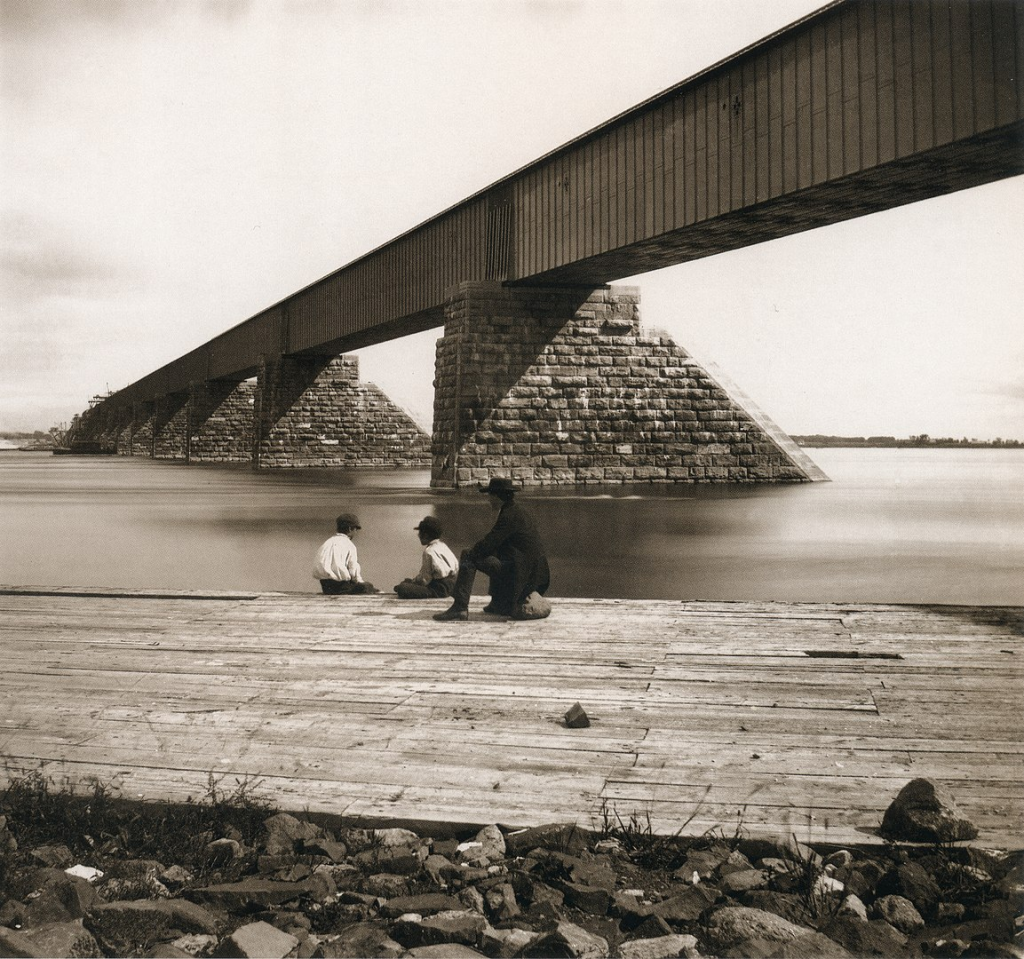Victoria Bridge, Montreal, QC.


Site Location: Lat.: 45° – 29’ – 29” N; Long.: 73° – 31’ – 48” W. (GPS: 45.4914604, -73.5301265). From the Trans-Canada Highway, Autoroute 40, take Autoroute 15 S/ Autoroute Décarie for 5.1 km. Take Exit 63E on the left for Autoroute 720 E/Autoroute Ville Marie toward Centre Ville. Proceed 5 km and take Exit 4 for Rue de la Montagne S. After 1.4 km, turn right onto Rue Wellington/QC0112 E (following signs for Pont Victoria). After 0.5 km, used the left lanes to turn onto QC-112 E and proceed 2 km to the bridge.
Plaque Location: The plaque is currently mounted on a stone cairn adjacent to a parking lot at the north west corner of the Rue des Irlandais/QC-112 intersection. (GPS: 45.487280, -73.545737). Travelling east on QC-112 E, turn left (north) on Rue des Irlandais 90 m past the “Black Rock” Montreal Irish Memorial and, after 100 m, turn left (west) into the parking lot. The cairn is at the south east corner of the parking lot.

Description: The Victoria Bridge was erected between 1854 and 1859 for the Grand Trunk Railway upstream from a site previously proposed by Thomas C. Keefer. The tubular structure was designed by Robert Stephenson, who also designed the tubular Britannia Bridge across the Menai Strait in England, and Alexander MacKenzie Ross, Chief Engineer of the Grand Trunk Railway. The contractors were the English partnership of Peto, Brassey and Betts, with James Hodges as Superintendent of Construction. The wrought-iron tubular sections were prefabricated in England for assembly on site. The Victoria Bridge was officially inaugurated by Albert Edward, the Prince of Wales, on August 25, 1860, in honour of his mother, Queen Victoria.
The poorly ventilated smoke from the engine made the six-minute crossing unpleasant.
The tubular superstructure was replaced by steel Pratt through trusses in 1898-99 to accommodate increased railway loadings. A lift bridge on the original alignment and the St. Lambert Diversion were added in 1958 to accommodate water traffic around the St. Lambert Locks of the St. Lawrence Seaway project. When the lift bridge was open, road and rail traffic on the bridge continued uninterrupted over the Diversion, south of the main bridge.
The bridge remains in active use today as part of the Canadian National main line between Halifax and Montreal.

(Source: McCord Museum)
Historic Significance: The 2 km (1.26) distance between abutments made the bridge the longest in the world in 1859, and it was called the ‘8th Wonder of the World”. The six-month annual construction season was very challenging. The tubular form was not successful in Canada (or elsewhere): it was heavy and expensive compared to through truss construction. The ice-breaking noses on the upstream faces of the piers were innovative, however, and became common for bridge construction in northern waters.
The bridge contributed greatly to the financial strength and power of the Grand Trunk Railway, which in turn shaped the growth and development that made Montreal Canada’s major metropolis.
Thomas Coltrin Keefer (1821-1915) was the founding president of the Canadian Society of Civil Engineers in 1887 and remained active in it, serving again as president in 1897. He was the first Canadian to become president, in 1888, of the American Society of Civil Engineers.

Plaque Wording: Site Historique National de Génie Civil. SCGC. PONT VICTORIA. Hommage aux ingénieurs qui ont conçu et dirigé la construction du pont tubulaire, 1859, du pont du jubilé, 1898 et de la Bretelle de derivation, 1960. Société canadienne de genie civil centenaire. 1887-1987.
CSCE. National Historic Civil Engineering Site. VICTORIA BRIDGE. A tribute to the engineers who designed and supervised the construction of 1859, the Tubular Bridge, 1898, the Jubilee Bridge, and 1960, the St. Lambert Diversion. Canadian Society for Civil Engineering Centennial. 1887-1987.
Links to Online Documentation:
Robert W. Passfield, “Construction of the Victoria Tubular Bridge”.
Wikimedia Commons, “Category: Victoria Bridge, Montreal” (109 images).
Michel Choquette, “Victoria Bridge: The 8th Wonder”, National Film Board, 1987.